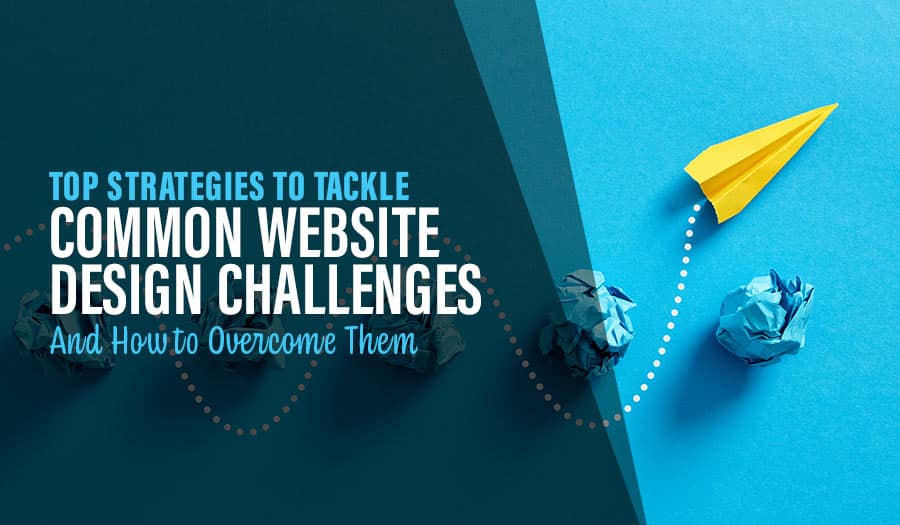In web design, challenges such as creating responsive layouts, ensuring cross-browser compatibility, and optimizing for performance are inevitable. “Common website design challenges and how to overcome them” is a topic that requires savvy strategies and practical solutions. This article dives into the top issues web designers face today and provides you with effective methods to tackle them, ensuring an optimal user experience across devices and browsers.
Key Takeaways
- Web designers must prioritize responsive design, user experience, and browser compatibility to cater to mobile users which account for more than 58% of global traffic, and ensure consistent performance across different devices and browsers.
- Optimizing website performance is essential to retain users, with techniques like image compression, code minification, and utilization of CDN being crucial to avoid high bounce rates due to slow load times.
- Incorporating SEO best practices within web design, maintaining user-friendly navigation, ensuring website security, and efficient team collaboration are fundamental in building successful and secure websites.
Critical Web Design Challenges Facing Today’s Designers
In the ever-evolving digital landscape, web designers, including a skilled web designer, grapple with many common web design challenges. One of the most substantial ones is creating responsive designs that cater to the growing number of mobile users, which account for over 58% of global site traffic. Web pages and web apps must adapt flawlessly to various screen sizes, maintaining both user experience and visual appeal.
Yet, the design process doesn’t end there. Modern web design also demands a focus on readability by optimizing content presentation and utilizing typography best practices. Prioritizing user experience in conjunction with the visual appeal of a website is of equal importance. A poor user experience can undermine even the most aesthetically stunning website design. This is where a user-centric design approach comes in. By striking a balance between aesthetics and functionality, web designers can ensure that the site is visually appealing while also serving its intended purpose effectively.
The ultimate goal is to create a consistent user experience, regardless of the device, browser, or screen resolution.
Ensuring Compatibility Across Different Browsers
The experience of a website can vary significantly across different browsers such as:
- Google Chrome
- Safari
- Firefox
- Microsoft Edge
This makes cross-browser compatibility a crucial aspect of web design. Users have diverse preferences and needs, which may lead them to choose different browsers. Therefore, compatibility across these browsers is vital for an uninterrupted user experience.
Addressing the differences among browsers, including legacy ones like Internet Explorer, is key to ensuring both performance and aesthetic consistency in web design. Tools like:
- CSS features
- JavaScript
- Vendor prefixes
- CSS reset styles
Come in handy for creating a design that works across browsers. Techniques like CSS reset and conditional loading can effectively manage rendering differences encountered in various browsers.
Additionally, understanding and implementing progressive enhancement and graceful degradation strategies can help mitigate cross-browser compatibility issues and ensure a consistent user experience.
Designing for Diverse Screen Sizes
In today’s mobile-dominant world, responsive design is no longer optional but a necessity. It allows the site to automatically adjust its content and elements to fit the screen size it’s viewed on. This adaptive nature of responsive design ensures a consistent user experience across different devices.
Designing for smaller screens, however, comes with its unique set of key web design challenges. Website designers should consider prioritizing top-of-page elements and decide on the visibility of these elements to avoid overwhelming users. This decision-making process helps ensure a positive user experience.
Some tips for designing for smaller screens include:
- Prioritize important elements at the top of the page
- Use a click-to-open method for menus to avoid hover-related issues
- Optimize images and videos for mobile devices
- To ensure that your website appears visually appealing and user-friendly on all screen sizes, it’s essential to implement responsive design techniques. This means that your website should adjust its layout and content to fit different screen sizes, including desktops, laptops, tablets, and smartphones. By utilizing responsive design, you can enhance the user experience and make your website accessible to a broader audience.
By following these tips, you can create a user-friendly experience for visitors using smaller screens.
Creating an Accessible Experience for All
Accessibility is a vital element of web design. It ensures that all website users, including those with disabilities such as visual or auditory impairments, can experience a positive user experience, in line with web accessibility guidelines (WCAG). But ensuring web accessibility isn’t just about inclusivity. It also serves as a smart business move by expanding reach and user satisfaction.
Inclusive design practices and adherence to legal standards such as WCAG are integral to addressing web accessibility as a top challenge in web design. Additionally, conducting regular accessibility testing helps in pinpointing areas of improvement, thereby aiding in the creation of a universally accessible digital platform.
Optimizing Website Performance for Better User Engagement
Given the myriad of options available to internet users, website performance becomes a significant factor in retaining audience attention. If a website takes more than three seconds to load, approximately 40% of visitors to successful site are likely to abandon it. This highlights the critical importance of optimizing website load times. Slow loading times not only frustrate users but can also lead to higher bounce rates and lower conversion rates.
A strategic approach to website performance optimization is necessary to address these issues. Utilizing techniques such as compressing images, minifying CSS and JavaScript, and leveraging browser caching can significantly improve website load times. These methods effectively streamline and minimize the time it takes for web pages to load. It’s worth noting that unoptimized images, bulky code, and server inefficiencies can contribute to slow website loading times.
This balance between speed and functionality is particularly important for ecommerce websites, where users may abandon slow sites before browsing products or completing purchases.
Speeding Up Load Times
Web designers need to ensure fast website loading times to avoid losing website visitors, which is a crucial concern for site owners. This can be achieved through various optimization techniques. For example, choosing performance-optimized hosting solutions that avoid shared hosting can provide more resources for individual sites, thereby enhancing page load time and speeds.
Effective web page caching can further improve load times by reducing the server resources required to serve a webpage. Compressing images and choosing the correct file format can significantly reduce their size, which in turn speeds up webpage load times. Additionally, eliminating unnecessary redirects helps decrease page loading times by making the HTTP request-response cycle more efficient.
Integrating Multimedia Without Compromising Speed
Balancing page speed and functionality presents a challenge as media elements can impact loading speed. Although multimedia elements can enhance user engagement, they can also slow down the website if not properly optimized.
One solution to this challenge is leveraging Content Delivery Networks (CDNs). CDNs enhance page loading speed by hosting and delivering content from servers distributed globally. This way, the inclusion of dynamic elements like animations and video backgrounds doesn’t compromise the overall performance of essential elements of the website.
Responsive Design: Crafting Sites for Mobile Users
Given the surge in mobile internet usage, responsive web design is now indispensable for a seamless user experience across various mobile devices. Achieving optimal responsive web design involves the use of fluid grids, flexible images, and media queries to adapt the design elements based on device capabilities.
Not only does responsive design enhance user experience, but it is also cost-effective. It offers the following benefits:
- It requires only one design that adapts to all screen sizes, simplifying website management and reducing updates and maintenance stress.
- It provides a uniform user experience for diverse devices and screen sizes, which is crucial for functionality.
- Search engines like Google reward responsive designs, making them an important aspect of modern web design.
Fluid Grids and Flexible Layouts
Fluid grid layouts are visual techniques used in responsive web app design to create adaptable layouts for different devices, such as desktops, tablets, and mobile phones. By using percentage values, web pages can adjust their width in relation to the screen size, contributing to a responsive design.
Customizing the gutter width or the white space in between columns in a grid can enhance the layout’s flexibility. Additionally, web designers must use flexible grids and scalable vector images to ensure that websites respond well to different device sizes.
Prioritizing Content for Mobile Devices
Responsive design is essential for determining which content is shown on mobile devices, with fluid grid layouts allowing for the effective display of important information. However, the challenge lies in deciding what to show and what to hide.
For a better mobile user experience, main menus should be simplified, using recognizable icons like the hamburger for menu triggers. Mobile menu designs can vary, including options such as full-width layouts, bottom drawers, or circular corner menus, to suit the context of the website’s content and number of links. This way, users are not overwhelmed with unnecessary information and can have a seamless browsing experience.
Search Engine Optimization Within Web Design
For optimal search engine visibility, it is vital to incorporate SEO practices into web design. Simple measures like minifying CSS, JavaScript, and HTML files by removing unnecessary characters can improve website loading speed and enhance SEO. Using the right headings and ensuring the site is index-friendly can further amplify the website’s visibility.
Adhering to web design best practices aids in quicker indexing by search engine crawlers, which in turn improves SEO rankings. Also, simplified navigation and clear URL structures aid search engine crawlers in accessing content more efficiently, which can improve a website’s SEO scores.
Moreover, Google’s algorithm favors mobile-friendly websites, making responsive web design a crucial factor in search engine rankings. Other SEO-friendly practices include optimizing images by reducing file sizes and adding descriptive alt text, and combining visually appealing design with high-quality content to lead to greater user engagement and longer visit durations, which are positive signals to search engines.
Navigating the User Journey with Intuitive Design
Effective navigation design is critical for intuitive and efficient website use, as it guides visitors through their journey. Menus should mirror user thought processes with a clear information hierarchy to enhance navigation intuitiveness. Descriptive link labels in menus are essential for users to quickly grasp the content to be expected, promoting a smoother navigation experience.
However, lack of clear navigation can result in increased frustration among users and higher website bounce rates. It’s therefore crucial to devise navigation systems that are intuitive and cater to user needs for a seamless user experience.
Structuring Navigation Menus
Effective navigation starts with well-structured menus. Using simple, descriptive menu names and relevant categories, and following web design best practices can create clear navigation structures. For sites with complex information hierarchies, multilevel menus can enhance navigation and findability, while limiting submenus to a maximum of two levels to prevent user confusion and cognitive overload.
Local navigation menus at the top of related pages can facilitate access to detailed information, thus enhancing user experience in sites with extensive and overlapping content. Incorporating visual indicators using icons like down arrows or triangles can help users recognize the availability of submenus. Additionally, features in menus that allow users to easily close them, such as X buttons or intuitive off-menu taps, along with navigation aids like a search bar, breadcrumbs, and a navigation footer, can further enhance usability across multiple devices.
Lastly, designing clear and compelling call-to-action elements can guide users on the next steps to take, supporting user engagement and facilitating conversion processes.
Enhancing User Flow with Interactive Elements
Interactive elements can significantly enhance user flow and make the user experience more memorable. Some examples of interactive design elements include:
- Animations
- Video backgrounds
- Interactive infographics
- Hover effects
- Scroll animations
- Micro-interactions
These elements can make web pages more engaging and visually appealing, adding a dynamic touch to the user experience.
On desktop sites, providing clear hover states and enabling keyboard navigation can enhance menu usability. However, when integrating these interactive elements, it’s important to strategically guide users without overwhelming them or negatively impacting site performance. This helps maintain a balance between engagement and usability, ensuring a positive user experience.
Balancing Form and Function in Web Design
Web design entails not only the creation of visually appealing websites but also the assurance of functionality. Balancing aesthetics with functionality is important to keep users engaged and prevent frustration with website navigation. This is where a user-centric design approach can help. By understanding the audience’s behaviors and needs, designers can make informed choices that align aesthetics with functionality.
The aesthetic aspect of web design should not only align with the website’s purpose but also actively support the message and emotions a brand wishes to convey, thus improving user experience. A consistent design approach, including unified color schemes, typography, and button styles, contributes to a more intuitive navigation and overall customer experience.
Security Measures in Web Design
Web design involves more than aesthetics and functionality; it also requires ensuring security. Conducting a security threat assessment before development starts can help in understanding the potential cyber threats and their impact. It’s important to proactively address common web security vulnerabilities like broken access control and security misconfigurations.
Regular security audits and penetration testing can evaluate the robustness of web applications against threats. Updating software components regularly is also vital to prevent exploitation of known security vulnerabilities. Moreover, implementing multi-factor authentication adds a crucial layer of security by requiring multiple forms of verification. Encryption techniques must be employed for protecting sensitive data both at rest and in transit, such as using TLS.
All these measures contribute to protecting websites from potential cyber threats.
Collaborating Effectively in Web Development Projects
Collaboration plays a key role in web development projects. Learning about co-workers’ processes and workflows can help improve collaboration and tailor suggestions effectively in remote web development projects.
Some visual collaboration tools that enable developers and designers to communicate more efficiently and asynchronously include:
- Trello
- Asana
- Slack
- Figma
- InVision
These tools can help streamline communication and enhance collaboration in web development projects.
A clear strategy roadmap at the beginning of a project can align team members’ efforts towards timely delivery and user satisfaction. Moreover, including clients in the development process and understanding their expectations can lead to more successful project outcomes. Building trust among team members is crucial, and suggestions made by developers to designers, or by users trust vice versa, should be given due consideration.
Adapting to the Evolving Tech Stack
Web design dynamics are in constant evolution, encompassing not only aesthetics and technologies but also user experience, site performance, and adaptability. One of the initial challenges in web design is selecting the appropriate right tech stack here, including deciding on whether to build a solution from the ground up or utilize existing frameworks and templates.
Professionals, including the web application developers, can succeed in the web design industry by leveraging specialized services, harnessing the capabilities of modern web applications, and maintaining a focus on user needs.
Streamlining the Design Process for Ecommerce Sites
Unique challenges are involved in the design process for ecommerce sites. The key to making websites convert and retain users lies in deeply understanding the users to know what makes them convert. Creating an engaging ecommerce site requires focusing on visitor interests, providing a positive user experience, and ensuring content is clear and readable.
Minimizing form fields on checkout pages to essential information and removing distractions can significantly improve user experience and checkout conversion rates. Here are some tips to enhance the checkout experience:
- Offer a guest checkout option
- Provide easy access to return policies
- Offer a variety of payment options
- Be transparent about shipping costs
By catering to user preferences and reducing hesitation, these strategies can help improve the overall checkout experience.
Furthermore, implementing a progress indicator, automatic form validation with error messaging, and available customer support during checkout can address user issues in real-time and keep users informed, further reducing cart abandonment.
Summary
In conclusion, web designers face many challenges in their pursuit of creating effective, engaging, and secure websites. By focusing on responsive design, ensuring cross-browser compatibility, optimizing website performance, and implementing security measures, they can overcome these challenges. Moreover, effective collaboration within the team and adapting to the evolving tech stack can streamline the web design process further. Whether it’s a simple blog or a complex ecommerce site, these strategies can help create a website that’s not only visually appealing but also functional, secure, and user-friendly.
Frequently Asked Questions
Why is responsive design important in web design?
Responsive design is important in web design because it ensures a consistent user experience across different devices by allowing a website to adjust its content and elements to fit the screen size it’s viewed on. This is essential for reaching and engaging with a diverse audience.
How can website performance be optimized?
To optimize website performance, you can use techniques such as compressing images, minifying CSS and JavaScript, leveraging browser caching, and selecting performance-optimized hosting solutions. These methods can significantly improve your website’s speed and overall performance.
What are some security measures in web design?
Incorporate security threat assessments, regular audits, penetration testing, updating software, multi-factor authentication, and encryption to enhance web design security. Regular vigilance and proactive measures are vital to mitigate potential threats.
How can collaboration be effective in web development projects?
To achieve effective collaboration in web development projects, it’s essential to understand your co-workers’ processes and workflows, utilize visual collaboration tools, and establish a clear strategy roadmap at the project’s outset.
What are some strategies to streamline the design process for ecommerce sites?
To streamline the design process for ecommerce sites, focus on understanding user preferences, minimizing checkout form fields, offering multiple payment options, and implementing a progress indicator, automatic form validation, and accessible customer support during checkout.
Take your business to the next level with a Pixel Fish Website.
Check out some of our latest Website Design projects.
View some case studies of our website design work:
Finvu
Smooth Current Electrical and Solar
Beautiful Group of Trades
Caplock
Further Information
Why you should use Elementor for your new WordPress Website
How To Turn Your Business Services Into Online Products
Building a Small Business Website: Key Steps and Best Practices
Practical Design Website Tips for a Successful Online Presence
Using Analytics to Prove Your Marketing Strategy ROI
How to Optimize Your eCommerce Website Design to Drive More Sales
Project Management Software Solutions for a Website Project



